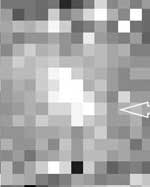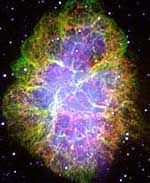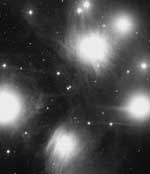
Image credit: JACH
A young, hot star has been found nestled inside a cocoon of molecular hydrogen gas half a light-year across. The star is called IRAS 07427-2400, and it’s sending out a solar wind so fast (360,000 km/h) that the shock waves are heating up the gas so it’s visible to Earth-based telescopes. Astronomers believe that these massive stars have so much energy that they blast their environment so that planets aren’t able to form the way they do around more “normal” stars, like our own Sun.
Astronomers have discovered a giant envelope or disk of glowing gas more than half a light year across, illuminated by shockwaves caused by winds travelling at up to 360,000 km/hour (220,000 miles/hour). The disk is orbiting a massive star 20,000 light years from Earth. This is the first time such a disk has been found emitting its own light. The discovery is reported today (8 December 2003) in the journal “Astronomy and Astrophysics”.
The work, led by Dr Nanda Kumar of the Centre for Astrophysics of the University of Porto (CAUP), Portugal, used the United Kingdom Infrared Telescope (UKIRT) in Hawaii, and other telescopes. The team used the new UKIRT Imager Spectrometer (UIST) on UKIRT, to study the young stellar object (YSO) known as IRAS 07427-2400. Their results show that the envelope or disk around the young star is glowing in the light of molecular hydrogen and ionised iron.
Dr Stan Kurtz of the National Autonomous University of Mexico (UNAM), who is an expert in studies of solar system sized disks around massive stars, said “Protostellar disks are known to exist around Sun-like stars, but they are usually seen in silhouette against background light from nebulae. In this case, however, the molecules in the disk are hot enough to shine brightly themselves.”
Dr Kumar adds “This is the first time an envelope like this has been seen in molecular hydrogen emission. It tells us that massive stars form with very different conditions and physical aspects when compared to Sun-like stars.”
The central star itself is very young, at roughly 100,000 years old. By comparison, our middle-aged Sun is about 5 billion years old. The surrounding gas disk is huge – its diameter is one thousand times larger than Pluto’s orbit in our own Solar System. The young star is rapidly changing as gas and dust spiral down onto its surface through the disk, a process called “accretion”. The star is already more than one thousand times more luminous than our Sun.
Dr Amadeu Fernandes of CAUP, Porto states “The UKIRT results show that the glow from the disk is not due to the intense light from the central star, but is instead caused by powerful shock waves”. Dr Chris Davis of the Joint Astronomy Centre in Hawaii explains “The disk is possibly being shocked by supersonic winds driven by the central star. These winds, travelling at hundreds of thousands of kilometres per hour, crash into the disk and heat the gas to thousands of degrees.”
Dr Kumar adds “It is also possible that the shocks are powered by large amounts of gas and dust collapsing through the disk onto the young star. Further investigation is required to understand their origin.”
Disks around young, Sun-like stars are known to be the birth places of planets, which can condense out of the gas and dust after the star has formed. This disk has about 150 times the mass of our Sun – enough gas and dust to make a hundred Sun-like stars, or many thousands of planets. However, the results suggest that it will not produce new planets or stars in the future. The intense shock waves have made the gas far too hot to condense. Dr Davis says “This tells us that massive stars like this may not be able to form planets, as their surrounding gas is too hot.”
Instead of forming a cluster of stars, or a family of orbiting planets, the disk will ultimately be destroyed by the intense ultraviolet radiation from the central star. The radiation is already at work, gnawing at the inner edges of the disk and evaporating the gas. Dr Kumar says “We’ve seen open rings of gas around similar stars, also with UKIRT. We think they may be the remnants of large disks that have been almost completely evaporated.”
The complete destruction of the disk will take many thousands of years. Before this happens, the size and brightness of the disk allow researchers to study it with powerful ground-based telescopes such as UKIRT, without the need for a space telescope.
Dr Davis says “We now have the task of searching for other hot, molecular disks around massive young stars, and of fitting the existence of this super-disk into our theories on the birth of massive stars.”
The disk was first discovered in January 2001 by UKIRT, but further observations were needed to confirm its nature. The team used the Caltech Submillimeter Observatory in Hawaii to provide supporting evidence to prove the rotating nature of the disk. Stan Kurtz used the Very Large Array radio telescope in New Mexico to image the central massive star at radio wavelengths. The team returned to use UKIRT in December 2002.
The work described is published on 8th December 2003 in “Astronomy and Astrophysics” volume 412.
Original Source: JACH News Release









